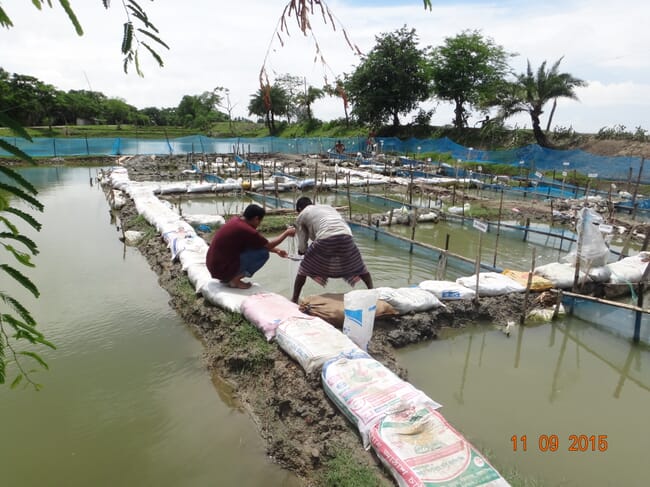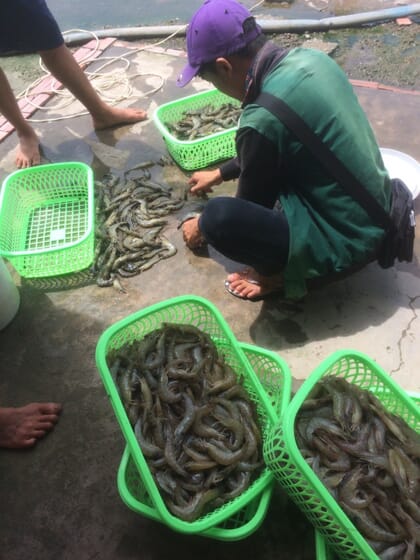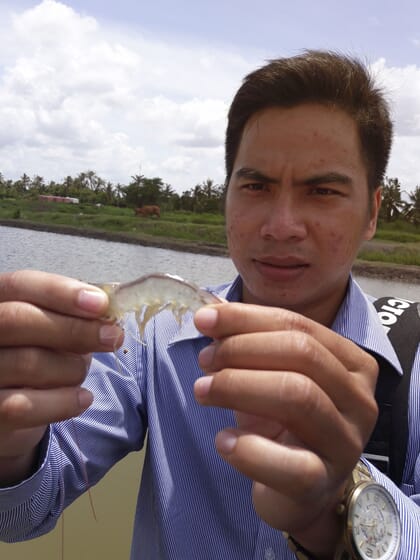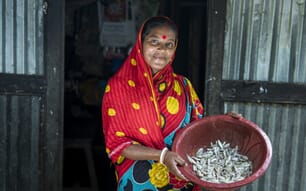As the global population grows, so does the demand for fish and the pressure on aquaculture to increase productivity. Enabling this increase is an expansion of fish and shellfish farming areas and an intensification of the production systems that provide roughly half of the fish and shellfish consumed worldwide.

© Kazi Ahmed Kabir
Intensive aquaculture relies heavily on commercially produced feeds, which use significant quantities of aquatic resources, such as fishmeal and fish oil, as well as terrestrial supplies such as cereals and pulses.
At present, aquaculture feeding systems generally target the cultured animals without considering the possible contribution of the pond ecosystem and its food web to the animals’ diet.
In these systems, the food web – the food chain within the pond from phytoplankton, microbes and other organisms through to the fish or shrimp being farmed – is stimulated by feed leftovers and wastes. These organisms in turn produce food for the fish or crustaceans.
However, aquaculture feed wastes do not consider the nutrient requirements of the food web, and this creates imbalance in the pond system. As a consequence, the wastes are only partially decomposed. The remainder accumulates, undermining the health of the pond environment and making it vulnerable to disease.

© Olivier Joffre
Many fish farmers address the problems that result from nutrient imbalances in aquaculture feed wastes by using disinfectants, mineral mixes, prebiotics and probiotics. In contrast, the “nutritious pond” concept aims to feed the fish or shrimp while also producing balanced wastes that are easily decomposed. As a result, waste accumulation is minimised, mineralisation is fast, the production of natural foods for the fish and shrimp is optimal and the pond environment stays clean and healthy.
At present, nutritious-pond feeds focus on optimising carbon-to-nitrogen ratios to accelerate the mineralisation of waste. Another advantage of using them is that carbon-rich ingredients are cheaper than nitrogen-rich ones, which reduces feeding costs.
Successful trials
The nutritious-pond concept is being trialled with whiteleg shrimp (Penaeus vannamei) in Vietnam and Nile tilapia (Oreochromis niloticus) in Bangladesh. The work is part of a five-year research project led by Wageningen University in the Netherlands in partnership with WorldFish, an international non-profit research organisation based in Malaysia.
In Vietnam’s Mekong Delta, iterative experiments over three years showed that a 20 percent reduction of the feed load, combined with additional cheap carbohydrate, achieved a similar yield to conventional shrimp-culture practices, while reducing operational costs by about 10 percent. On-farm trials showed higher individual growth per day in trial ponds compared to control ponds.
“In all the on-farm trials using this approach, ponds displayed more stable water quality and less vulnerability to disease outbreaks than a conventional feeding approach,” says Olivier Joffre, scientist at WorldFish.
“Experiments in tanks using corn starch as a source of carbohydrate also showed promising results, compared to more commonly used molasses. Ongoing research is fine-tuning the technology by looking at the most appropriate carbohydrate – corn starch, cassava or molasses – and type and frequency of application.”

© Tran ND Khoa
Higher yields
In Bangladesh, a recent study assessed whether lowering the dietary protein-to-energy (P:E) ratio below the known optimal ratio affects fish productivity, food-web dynamics and nitrogen balance in semi-intensive tilapia ponds.
“The results showed that the yield was 21 percent higher when fish were fed a low P:E diet,” says Kazi Ahmed Kabir, a PhD fellow jointly hosted by Wageningen University and WorldFish.
The better performance of fish with the concept diet was due to the diet’s enhancement effect on the natural food in the pond – 64 percent of the growth recorded was achieved from this natural food. In addition to the yield increase, the feed conversion ratio was also below one. The concept diet contained only 24 percent protein and 3 percent fishmeal. In conventional feeds this is typically between 30-35 percent protein and 10-15 percent fishmeal.
Use of this concept diet thus has the potential to reduce the feed cost and increase the profitability of tilapia aquaculture in ponds for both small-scale and commercial farmers, according to Kabir.
“At the same time, it increases the sustainability of the fish-feed industry by minimising the use of fishmeal and reducing the inclusion of dietary protein,” he adds.

© Olivier Joffre
Commercial spin-offs
The nutritious-pond concept is being developed in cooperation with industry partners (Nutreco, Skretting Vietnam and the Viet-Uc shrimp farming company), universities and research organisations (Wageningen University, Can Tho University in Vietnam and WorldFish), extension workers and small-scale farmers. This multi-stakeholder approach has helped to better fit the feed system to the local context and, once the project is complete, may facilitate adoption of the technology.
Now entering its final phases, the project expects to translate its findings into new commercial products such as low-protein feed and culture protocols, making pond aquaculture more profitable, sustainable and predictable.
This article is part of a series for The Fish Site on the contribution of sustainable aquaculture to food and nutrition security in developing countries. The research was supported by NWO-WOTRO Science for Global Development and the WorldFish-led CGIAR Research Program on Fish Agri-Food Systems.





